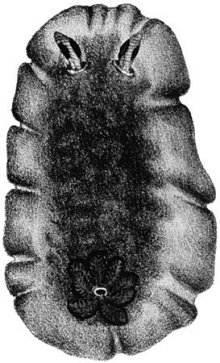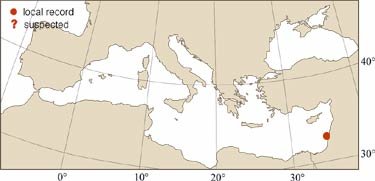
|
Relevant Synonyms
Misidentification
|
|
| drawing: Rüppell and Leuckart, 1830 (MNHN, Paris) |
|
SHORT
DESCRIPTION
color :
very variable, typically dull. Brodie et al. (1997) distinguished three color forms: grey, black and orange/red, that can also include variable levels of yellow, brown or pink. The original description corresponds to the grey form as well as to the Mediterranean specimens.
common size :
30-40 mm in lenght, max. 90 mm. |
DISTINGUISHING CHARACTERISTICS
BIOLOGY / ECOLOGY
habitat :
one of the most common, shallow water, Indo-Pacific nudibranchs; found in calm areas of bays on rocky coasts, on back reefs and shallow tidal areas of rock and coral rubble. |
|
1st
Mediterranean record
|

|
|
DISTRIBUTION
|
ESTABLISHMENT SUCCESS
speculated reasons for success :
|
|
|
MODE OF
INTRODUCTION |
IMPORTANCE TO
HUMANS |
|
KEY
REFERENCES
|
|
|
 Doris fumata Rüppell and Leuckart, 1830
Doris fumata Rüppell and Leuckart, 1830